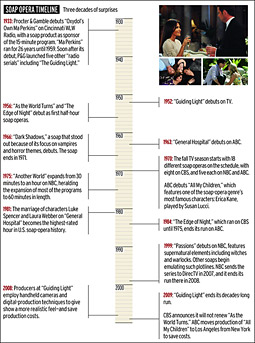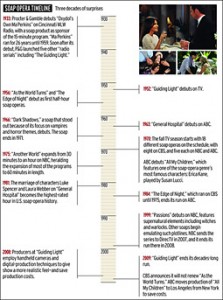For several years, there have been numerous reports predicting the end of the soap opera genre. At least one nail has been added to the soap opera genre coffin annually since 1997, with the cancellation of Passions, Guiding Light (the first soap ever that began on radio in 1937), and most recently, As The World Turns. This leaves just six soaps remaining, a major decrease from the 1970s when NBC, ABC and CBS were running 10 hours of soaps per weekday or the 1969-70 season when 17 soaps were on the air!
Though some will say that soaps were, and those that remain still are, a waste of time with their often recycled story lines such as who’s sleeping with whom, character X revived from death four times, and a long-lost sibling appearing from thin air, there are those of us that realize soaps have had some real value in bringing societal issues to the forefront of our consciousness. In particular, the soap operas of Agnes Nixon became known in the 70s, 80s and 90s for their frank depiction of issues with stories about rape, abortion, infertility, depression, child abuse, AIDS, and a variety of other controversial topics. More recently, daytime TV has had its first lesbian character, transgendered character and lesbian wedding. Yet these storylines have not been able to save the shows that multiple generations of women, and yes, even some men, grew up watching.
There are many hypotheses on what has brought about the demise of soaps. Almost all are plausible in one way or another, but the increase in number of women in the workforce is perhaps the largest contributor to the genre’s downfall. According to the Bureau of Labor Statistics, in the 1970s the labor force was approximately 42% female. That number jumped to 57% in 2000 and still hovers in the mid-50s today. Women have always dominated the viewing audience for soaps, and the increase in working women left fewer viewers at home to sustain ratings. Some believe that soap opera viewing is passed down from generation to generation, therefore, working moms will not “pass down” the interest to their female children. While this may hold true to some degree, there are many die-hard soap fans that were turned onto the genre not because of their mothers but their friends (I fell into that category). Fifteen to 20 years ago, teen and pre-teen girls went home after school, grabbed a snack and settled down to a 3 PM episode of their favorite show; this was and still is the last soap timeslot of the day. Today, teens, and an increasing number of pre-teens, are spending more time online due to the sheer variety of activities afforded to them by the Internet (shopping, texting, Twitter, Facebook, etc.). According to a report from the National Adolescent Health Information Center, the number of teens using the Internet daily increased to 61% in 2006, up from 42% in 2000. These figures do not account for the proliferation of smartphones and the increase in teens with “old-school” cells phones. Overall, according to Nielsen, the average number of soap viewers for the 2009-2010 season was a mere 1.3 million compared to 6.5 million during the 1991-1992 season.
The expansion of cable has also changed the TV landscape. No longer are daytime viewers limited in what they can watch. Primetime dramas, reality shows and docu-dramas can be found anytime of day on a plethora of cable stations. Though the big three networks, in particular CBS and NBC with only one soap opera left in each of their lineups, are replacing their cancelled soaps with reworked game shows like Let’s Make a Deal and talk shows with Julie Chen and Sharon Osborne discussing contemporary issues, a certain group is not pleased with the change: ad buyers. In a July 2010 article from The Wrap, ad buyers reported, “that soaps are still one of the most cost-effective buys on broadcast television.” One even went as far to say that soaps “are even more efficient than much of daytime cable programming,”
Losing the soap opera genre completely may occur without the average person giving it a second thought. On the other hand, advertisers (think cleaning products, soaps, tampons, etc.) and their media buyers alike may notice a significant challenge to reach what once was their main target audience, homemakers. They will need to find a new way to market their products to working women. And for those of us who simply grew up with “the stories,” we’ll remember the days of soaps and tell our children about the ones we loved.
Related articles by Zemanta
- Soap Opera Ratings Fall as Daytime TV Ratings Rise (adage.com)
- Daytime TV’s New Entries Push Soaps Toward Drain (adage.com)
- As Daytime Soaps Circle the Drain, Ad Buyers Weep Loudest (thewrap.com)
- The Demise of Soap Operas (nytimes.com)



